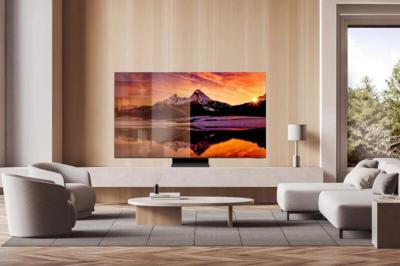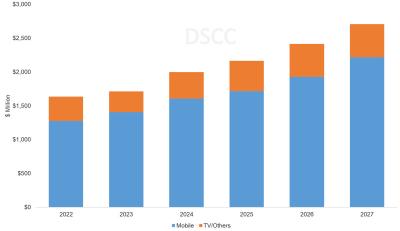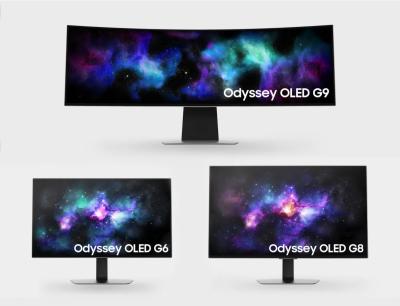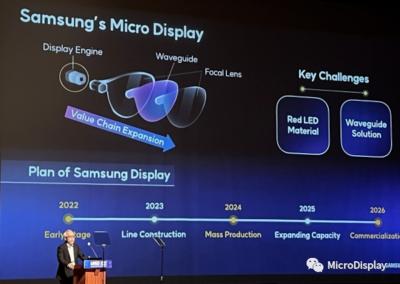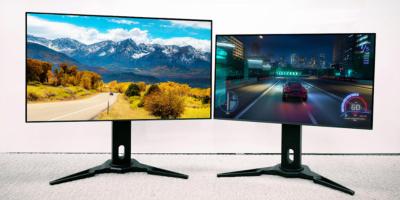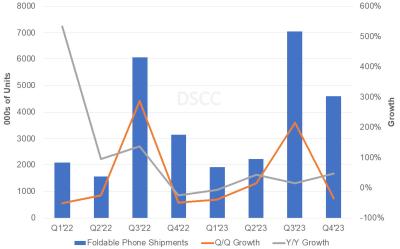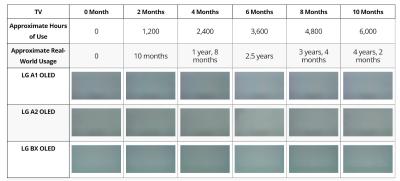OLED is an emerging display technology that is fast becoming the mainstream display technology in many markets, as OLED enables display panels that offer the best image quality and free design as they can be made flexible and transparent. The Samsung OLED displays are considered to be the best in the industry and the Korean company is the clear lead in AMOLED production for mobile devices.

Over the pay years Samsung invested billions of dollars in OLED research and production facilities as the company sees OLEDs fast replacing LCD displays in all mobile applications.
Samsung AMOLED displays
Samsung is currently producing over 300 million AMOLED displays in a year, used mostly in smartphones - such as Samsung's own Galaxy S7 (and S7 edge ) - but also in smartphones from Gionee, Meizu, Acer, HP, Vivo, Microsoft, Lenovo, ZTE, Hisense, Konka and others. Samsung also produces large mobile OLEDs for tablets, laptops and monitors.
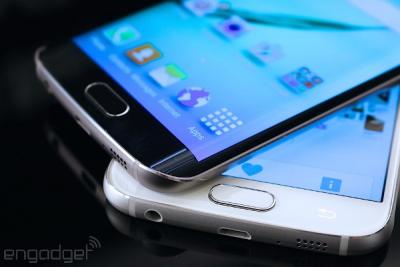
In August 2013 Samsung launched the company's first OLED TV, the KN55S9C, which used a curved 55" OLED panel. The TV was priced at around $8999 in the US and Korea, but is no longer in production, and was never in real mass production. In 2022, Samsung returned to OLED TV production, and is now offering QD-OLED panels and its first such TV is the S95B.
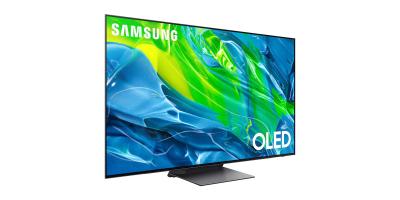
Samsung flexible OLED displays
Following its initial flexible OLED production launch in 2013, and the huge success of its edge-type phones, Samsung is currently producing around 9 million flexible OLEDs each month to satisfy demand for the Galaxy S7 edge and its other flexible OLED products. Samsung has reportedly been chosen to supply 100 million flexible OLED panels to Apple's future iPhones.

Future Samsung OLED devices
Samsung is developing several next generation display technologies based on OLEDs. Samsung has been developing a foldable OLED device for a long time - which may dramatically change the mobile device market as it could enable smartphone to turn into tablets or phones that can be folded into smaller devices.
Samsung is also developing transparent OLEDs (see the company's 55" FHD transparent and mirror-type OLEDs here) for retail application, and also readies next generation displays for the automotive industry.
Several years ago Samsung released the following video, showing a concept transparent flexible AMOLED tablet device. It will be years before Samsung can commercialize such a display, but it's nice to see what the future holds:
Further reading
The latest Samsung OLED news:
Samsung unveils its 2024 OLED TV lineup
Samsung Electronics announced its 2024 OLED TV lineup, with 3 series. The company's flagship OLED TV for 2024, the S95D, offers 55-, 65-, or 77-inch 4K 144hz QD-OLED panels, offering high brightness (up to 3000 nits peak brightness), a new anti-glare coating to minimize reflections, Tizen 8.0 OS, and an external One Connect box for a sleek design. The S95D offers AI-Enhanced color accuracy - validated by Pantone.
Samsung also announced two more series - S90D and S85D. Interestingly, it did not detail whether these TVs use QD-OLED (produced by SDC) or WOLED panels (produced by LGD) - or a mix as it did last year within the same series.
Samsung Display demonstrates its latest rollable and foldable automotive OLED panels
Samsung Display is showing its latest rollable automotive OLED panel, at CES 2024. The company says that this display, still at a prototype-stage, incorporates new technologies that enables it to be 30% thinner compared to SDC's previous rollable OLEDs.
Samsung is showing a wide of automotive OLEDs, including a display that is both rollable and foldable, check out the video above. There's also the round 9.4-inch AMOLED that will be used in the upcoming 2025 Mini Cooper.
DSCC: the OLED materials market to grow from $1.7 billion in 2023 to $2.7 billion in 2027
DSCC estimates that the market for OLED evaporation materials (i.e. OLED stack materials) will reach $1.7 billion in 2023, and will grow to $2.7 billion in 2027 (a 11% CAGR from 2023). If UDC will succeed to commercially introduce a blue phosphorescence material, revenues can even be much higher.
OLED materials used in TV applications (and other large-area applications) will grow from $305 million in 2023, to $492 million in 2027, a 13% CAGR. DSCC also sees very fast growth in material used to produce tandem-structure IT displays, which will grow at a 79% CAGR to reach $443 million in 2027.
Demand for Samsung's rigid smartphone AMOLED panel is on the increase in China
According to reports in China, strong demand for flexible AMOLED panels for high-end smartphones, have resulted in an increase of panel price. This has caused smartphone makers to adopt more rigid AMOLED panels in their budget smartphones.
The report suggests that Samsung Display is especially enjoying an increase in sales of its rigid AMOLED panels to smartphone makers in China - mainly OPPO, vivo, and Xiaomi. These smartphone makers are replacing LCD displays with Samsung's rigid AMOLEDs - as the price difference is currently quite small.
Samsung announces its 2024 QD-OLED gaming monitor range
Samsung Electronics announced their upcoming 2024 QD-OLED gaming monitor range. It starts with the flagship Odyssey G9 (G95SD) gaming monitor that offers a curved 49-inch 32:9 5120x1440 240Hz QD-OLED panel.
The other two monitors offer a flat panel. The Odyssey G6 is a 27-inch 1440p monitor that offers very fast 360Hz refresh rate, while the Odyssey G8 (model G80SD) is a larger monitor, with a 32" 240Hz QD-OLED panel.
Samsung : SDC to focus on OLED microdisplays while SSI will handle its Micro-LED development
In 2022, Samsung Display confirmed it is developing OLED microdisplays, and the company has since stepped up its efforts to bring OLED microdisplay to the market. The company is also developing microLED microdisplays.
It is now reported in Korea that Samsung Electronics decided that from now on, Samsung Display will handle all OLED microdisplay projects, while Samsung Semiconductor (SSI, or specifically, the Compound Semiconductor Solutions team) will handle all microLED microdisplay development.
SDC upgrades its QD-OLED line, starts producing 31.5" 4K panels
Samsung Display announced that it is beginning to produce a new 31.5" 4K QD-OLED. This is SDC's highest density QD-OLED display, at 140 PPI. The company recently upgraded its QD inkjet printing deposition system to support this higher resolution. It will also enable SDC to produce 8K 65" QD-OLED displays (that will also be 140 PPI).
Samsung Display also announced that next year it will start producing 27" QHD QD-OLED monitor panels that will support a 360Hz refresh rate, targeting the gaming monitor market.
DSCC: 2023 is a mixed year for foldable smartphone, shipments to reach 15.8 million units
DSCC estimates that foldable smartphone shipments reached 7 million units in Q3 2023, up 16% from last year and 215% from last quarter, as Samsung successfully launched the ` and Z Fold 5 phones, and other smartphone brands from China also ramped up their foldable smartphone sales.
Samsung's market share in the smartphone market was 72%, followed by Huawei (9%) and Honor (8%). DSCC expects foldable smartphone sales to fall 35% in the next quarter (but rise 47% compared to last year) on lower Samsung shipments and delays in new product announcements. In 2023, DSCC sees foldable smartphone shipments to reach 15.8 million units in total.
UBI Research: OLED material sales to reach $2.43 billion in 2028
UBI Research updated its forecast for the OLED material industry, saying that total sales of OLED materials will grow from $1.84 billion in 2023 to $2.43 billion in 2028, a growth of 5.8% CAGR.
UBI says that in 2028, SDC will purchase OLED emitters in $810 million, LGD in $550 million and BOE in $440 million.
Rtings.com posts the results of its 10-month OLED and LCD display longevity tests
RTINGS.com posted an interesting article, detailing the results of their long-term (10-months) longevity tests on several OLED and LCD TVs and monitors. The test is simple - display a CNN feed constantly, and checking what happens. Note that CNN changed their logo a bit a few months into the test, but the team did not make any changes to the test itself.
As is expected, OLED monitors and TVs suffer from image retention problems, and the CNN logo is visible in some of these panels, when showing a gray screen. Some TVs suffer more than others.
Pagination
- Previous page
- Page 4
- Next page
